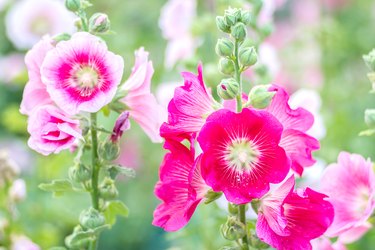
New gardeners become frustrated when weeds infiltrate their gardens. If life has gotten in the way and you haven't given your garden the attention it deserves, you may find some weedy mallow look-alikes or other plants that have blended into the garden, making a positive identification difficult. Save yourself the heartbreak of accidentally culling your hollyhocks (Alcea rosea) by learning to identify weeds with a similar appearance. Hollyhocks grow as short-lived perennials in U.S. Department of Agriculture plant hardiness zones 3 through 8.
Hollyhock Leaves and Look-Alikes
Video of the Day
Mallow weed (Malva neglecta), also known as common mallow, is a distant cousin of the hollyhock. Mallow weed foliage resembles hollyhocks leaves. The blooms are the distinguishing feature; common mallow has white, pink or lavender flowers dissimilar in shape to hollyhock blooms. Leaves are alternate, hairy and have a circular or kidney shape with five to nine shallow, serrate, pointed lobes.
Video of the Day
The spread of common mallow is not like that of hollyhocks: hollyhocks grow erect; mallow weed grows prostrate. Mallow weed is common throughout the United States. It may appear as an annual plant in all zones or a biennial in USDA zones 4 through 8.
Creeping Charlie Look-Alikes
Creeping Charlie (Glechoma hederacea) is a perennial weed in the mint family (Lamiaceae) that features leaves resembling hollyhocks, but on a miniature scale. Creeping Charlie can be confused with hollyhocks' young, new growth. The leaves are circular to kidney-shaped, with scalloped edges and a thin coating of down. However, as the creeping Charlie grows, it soon becomes clear that it is not a hollyhock.
Creeping Charlie spreads as a prostrate vine through gardens and yards. The flowers are blue and lavender and look like mutated, miniature pansies. Creeping Charlie is native throughout the United States. It prefers shady, moist areas, but readily adapts to other environments in USDA zones 3 through 10.
Scarlet Globemallow Flowers
Scarlet globemallow (Sphaeralcea coccinea), also called slippery elm, is another distant cousin of the hollyhock plant. Scarlet globemallow grows erect, reaching about 2 to 3 feet tall. Its leaf shape, which is palmate with three to five deep lobes, is dissimilar to hollyhocks. However, like the hollyhock, scarlet globemallow leaves are hairy.
Scarlet globemallow is among the many weeds that look like flowers. Their blossoms are similar to hollyhock blossoms with short stalks and elongated clusters, in hues of orange, red and pink. The scarlet globemallow is drought resistant and may actually grow larger during times of neglect or stress. Scarlet globemallow favors dry grassland areas in USDA zones 6 through 8.
Wild Hollyhock Plants
Wild hollyhock (Sidalcea virgata) also called Cusick's checkermallow, is a native wildflower or weed that is endemic to, and endangered in, the Pacific Northwest. Wild hollyhocks resemble domestic hollyhocks in bloom and growth habit.
Both plants grow upright and have a short-stalked, elongated flower. Wild hollyhocks produce pink blooms in mid-spring to early summer. They grow to about 4 feet tall and thrive in wet areas with full sun in USDA zones 7 through 8.
Miniature Hollyhocks in the Garden
Another hollyhock look-alike, but in a smaller size, are the miniature hollyhocks (Sidalcea malviflora). Related to and sharing the common name checkermallow or checker bloom, these native wildflowers grow 18 to 31 inches tall in USDA zones 5 through 9. From a distance, the flower spikes resemble the much taller hollyhocks found in informal and cottage gardens. Like other wildflowers, miniature hollyhocks could be considered weeds when growing in the wrong location, though several cultivars have been developed for home gardens.